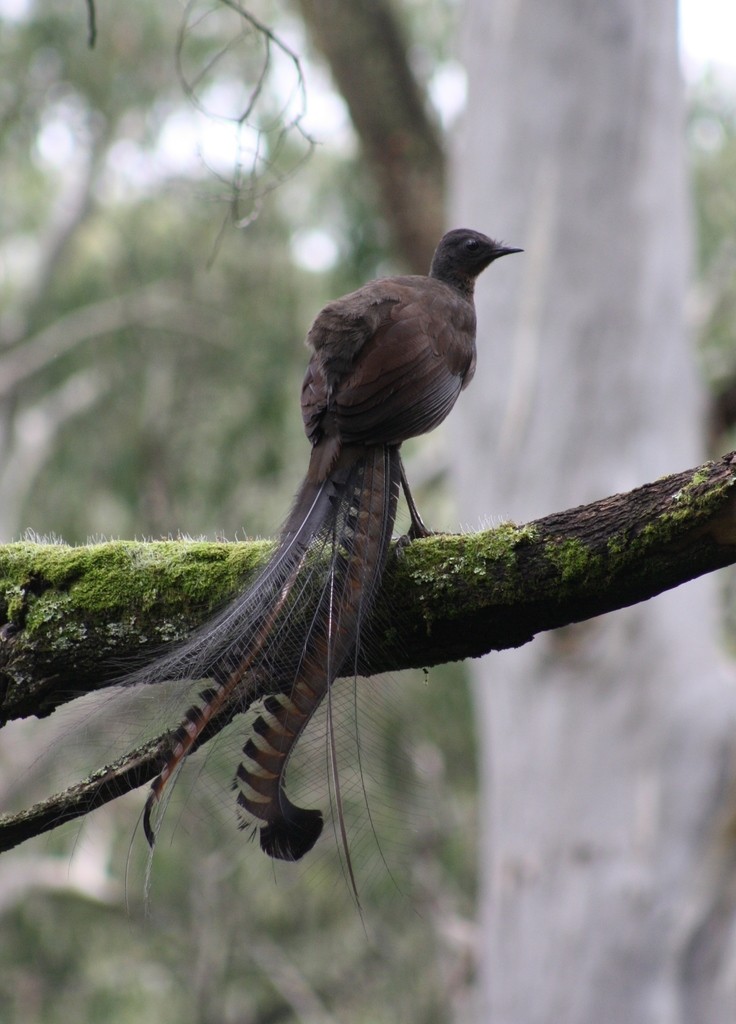Superb Lyrebird
A species of Lyrebirds Scientific name : Menura novaehollandiae Genus : Lyrebirds
Superb Lyrebird, A species of Lyrebirds
Botanical name: Menura novaehollandiae
Genus: Lyrebirds
Content
Description People often ask General Info
 Photo By silversea_starsong , used under CC-BY-NC-4.0 /Cropped and compressed from original
Photo By silversea_starsong , used under CC-BY-NC-4.0 /Cropped and compressed from original Description
The superb lyrebird is a large, pheasant-sized terrestrial passerine, ranging in length from 860 mm (34 in) for the female to 1 m (39 in) for the male. Females weigh around 0.9 kg (2.0 lb), and males weigh around 1.1 kg (2.4 lb). The plumage colour is mainly dark brown on the upper body, with greyish-brown underparts and red-tinged flight feathers. The wings are short and round, and are only capable of weak flight, being mainly used for balance or for gliding from trees to the ground. The legs are powerful, capable of running quickly, and the feet are strong enough to move branches up to 10 cm in diameter. Lyrebirds are renowned for their ornate tails. Adult males have tails up to 700 mm (28 in) long, consisting of sixteen feathers. The outer two feathers, the lyrates, are broad S-shaped feathers, originally named for their resemblance to the shape of a lyre, and have brown and buff coloured patterning. Between the lyrates are twelve filamentaries, feathers of flexible silvery barbs. In the centre of the tail are two silvery median feathers. The tail of the female is less ornate, with shorter lyrates and plain, broad feathers in place of the filamentaries. In both sexes, juveniles have no ornamental tail feathers. The tail plumage develops into that of the mature bird through a series of annual moults, with feathers undergoing change in structure and patterning. The male superb lyrebird reaches maturity in 7–9 years, and the female in 6–7 years. 
Size
76 - 103 cm
Colors
Brown
Black
Gray
White
Life Expectancy
20 years
Nest Placement
Ground
Feeding Habits
Superb Lyrebird primarily eat invertebrates and fungi, foraging by scratching the forest floor. They prefer damp, open understories for easier access to food.
Habitat
Superb Lyrebird's habitat spans a range of forested environments in southeastern Australia, from lowland rainforests to subalpine zones. These birds thrive in areas with rich leaf litter, dense canopies, and are often found amid ferns and eucalypt woodlands. Habitats range from wet to dry sclerophyll forests, and even alpine regions.
Dite type
Omnivorous
People often ask
General Info
Feeding Habits
Bird food type
Behavior
Superb lyrebirds are ground-dwelling birds that typically live solitary lives. Adults usually live singly in territories, but young birds without territories may associate in small groups which can be single or mixed-sex. Lyrebirds are not strong fliers and are not highly mobile, often remaining within the same area for their entire lifespans. Superb lyrebird territories are generally small, and there are known behavioural differences between different populations. 
Distribution Area
Lyrebirds are ancient Australian animals. The Australian Museum contains fossils of lyrebirds dating back to about 15 million years ago. The prehistoric Menura tyawanoides has been described from early Miocene fossils found at the famous Riversleigh site. The superb lyrebird is found in the forests of southeastern Australia, ranging from southern Victoria to southeastern Queensland. The bird was introduced to southern Tasmania in 1934–54, amid ill-founded fears the species was becoming threatened with extinction in its mainland populations. The Tasmania population is thriving and even growing. Across the rest of its large range, the lyrebird is common, and is evaluated as being of least concern on the IUCN Red List of Threatened Species. This range of the superb lyrebird includes a variety of biomes, including subtropical and temperate rainforest, and wet and dry sclerophyll forest. The preferred habitat of the bird is in wet forest and rainforest, where there is an open ground layer of moist leaf litter shaded by vegetation. In favourable seasons, the lyrebird range is often extended into drier areas further from water sources. 
Species Status
Not globally threatened.
Scientific Classification
Phylum
Chordates Class
Birds Order
Perching birds Family
Lyrebirds Genus
Lyrebirds Species
Superb Lyrebird